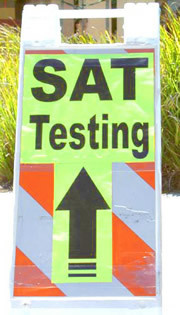
The admissions staff at the University of Notre Dame is keeping awatchful eyeon scores from the new writing component of the SAT college entrance exam, and plans to continue this tentative acceptance for the next few years until further research can validate its effectiveness.
In the past few months, some 3 million prospective college students have taken the expanded SAT with its new 25-minute essay.They were required to write about a general theme, using examples from literature, history or personal experience. The new section derives one-third of its score from a written essay and two-thirds from multiple choice grammar and comprehension questions.
No longer 1,600, perfection on the SAT now requires a score of 2,400800 on each of the three sections, writing, critical reading and math.
Although the new crop of SAT scores appears steroid-enhanced, adjusting to them is requiring little heavy lifting, according to Robert Mundy, director of admissions operations at Notre Dame.
Mercifully, the SAT publishers promised an apples-to-apples comparison between previous yearsverbal and math scores and critical reading and math scores,Mundy said.The writing portion, which examines grammar, usage and essay writing ability, serves as a freestanding add-on.
Aside from the obvious changes, there could be other ramifications of the new essay portion of the SAT.The National Council of Teachers of English has criticized it as a poor predictor of how well students will perform in college, and has expressed concern that it could encourage students to treat writing as a formula.
Sharing these worries, among others, is Stuart Greene, associate professor of English at Notre Dame and the OMalley Director of the University Writing Program.
Unfortunately the writing component of the SAT furthers a long-standing tradition of formulaic writing that ignores the role writing can play in personal growth or that readers play in utilizing the information provided,Greene said.The writing that students will produce for the SAT does not approximate the wide range of uses writing can provide as a form of learning or thinking.Moreover, it does not begin to approximate the kind of writing students will be expected to produce at a university, such as interpreting complex texts in philosophy, theology, political science, and the like, and integrating their interpretations into essays in which they also advance their own arguments.
The College Board, which owns the SAT, challenges such criticism by insisting that the new SAT will help foster more writing instruction in schools at a time when its desperately needed, and will provide college admissions counselors with samples ofstudentswriting.
For the next few years,Mundy said,the admissions staff at Notre Dame will concentrate on the two traditional components of the SAT, while keeping a watchful eye on the writing scores.Further research should indicate what kind of successes the writing component predicts.
The second college admissions test that Notre Dame accepts, the ACT, offers a voluntary writing component, which the University does not insist students take.
The nearly 2,000 members of Notre Dames class of 2009will arrive on campus next month with an average SAT score of 1375eight points higher than that of the previous class of freshmen and a source of pride for the University.Each year the average score of the incoming freshmen elevates by a handful of points, however due to the expanded test, next year it will take a dramatic leap.By studying percentile comparisons from year to year, the admissions office will continue to be able to compare relative strength from one class to the next.
TopicID: 12203